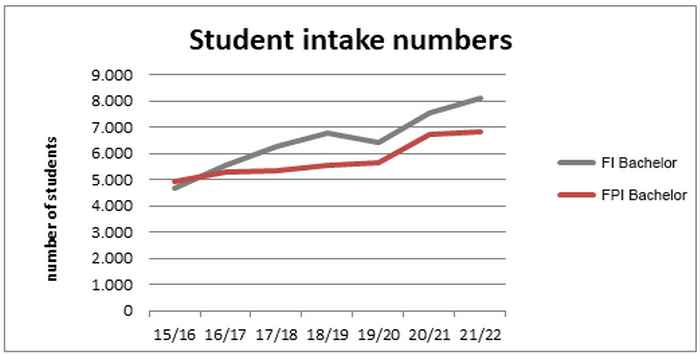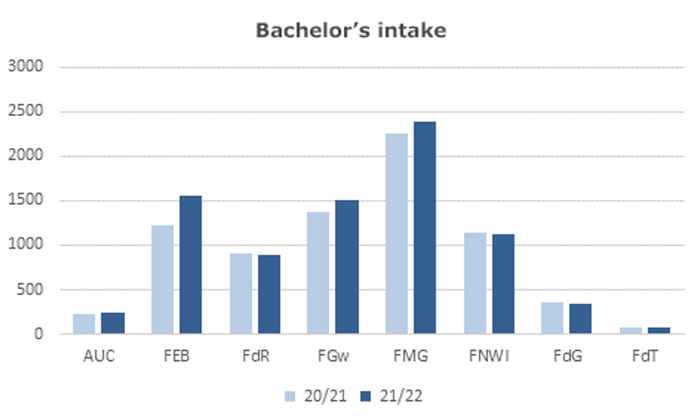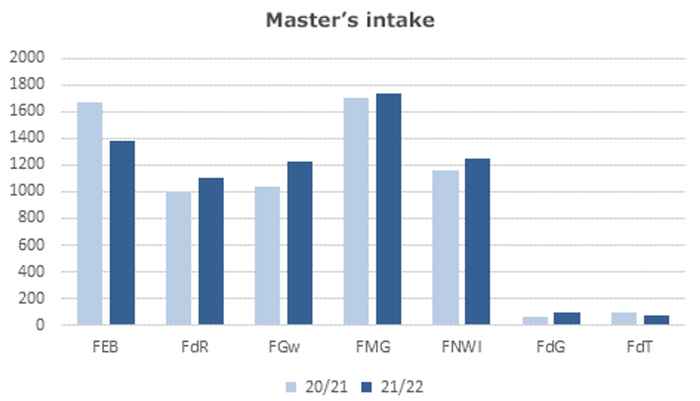Intake numbers for Bachelor’s and Master’s students increase again
4 November 2021
These are provisional figures as of 17 October 2021. The definitive figures will be known in February 2022.
‘At the UvA we have been seeing very strong growth in the number of students, especially international students, for many years now. This year we crossed the 40,000 mark,' says president of the Executive Board Geert ten Dam. ‘At the UvA, we have high-quality education, a curriculum with offerings in both Dutch and English, relatively low tuition fees for students from the EU, and the city of Amsterdam itself is a magnet for many. The fact that so many students choose our university is a great compliment, but the pace at which student numbers at the UvA – and also at other Dutch universities – are increasing, is no longer manageable. Quite apart from the lack of space on the campuses and huge shortage of student accommodation, the workload for employees has become unacceptably high. We cannot and do not want to grow anymore. Instruments must finally be put in place to allow us to better control the intake, and structural investments must finally be made in higher education.'

The fact that so many students choose our university is a great compliment, but the pace at which student numbers at the UvA – and also at other Dutch universities – are increasing, is no longer manageable.Geert ten Dam, president of the Executive Board
Bachelor’s intake
The number of first-year students in Bachelor's degree programmes increased from 7,540 to 8,126, a difference of +8%. As can be seen in figure 2, the increase is greatest at the Faculty of Economics and Business (FEB), the Faculty of Humanities (FGw), and the Faculty of Social and Behavioural Sciences (FMG). At the Faculty of Law (FdR) and the Faculty of Science (FNWI) the number of first-year students has gone down very slightly.
Of the new Bachelor's students, 4,886 come from the Netherlands and 3,240 from abroad. Last year those numbers were 5,113 and 2,427, respectively. The number of new international Bachelor's students will therefore increase by 33%; the number of new Dutch bachelor students falls by -4%. The majority of international students come from the European Union: 2,251. The increase in the number of students from Poland (from 107 to 202; +89%), Romania (from 94 to 166; +77%), and Italy (from 158 to 223; +41%) is striking. From outside the EU, the number of first-year students from China is increasing sharply (from 110 to 206; +87%). The Bachelor's intake from the US and Canada decreased last year but is now increasing again (from 58 to 97; +67%).
New Master’s students
The Master’s intake has increased: there are 6,845 new masters students this year compared to 6,716 in 2021. This number includes the transfer of students who have not yet fully completed their Bachelor’s. Due to the corona pandemic, the so-called 'hard cut' (meaning that students may only start their Master's after completing their Bachelor's) was abandoned in the past academic year, just as it was in the year before. The number of 'soft cutters’ (students who have started their Master's programme having not yet fully completed their Bachelor's degree) is approximately the same this year as last year: about 8% (527 students) of the total intake for the Master's degree programmes. The largest increase in the number of Master's students can be seen at the Faculty of Humanities FGw), followed by the Faculty of Law (FdR), the Faculty of Science (FNWI) and the Faculty of Social and Behavioural Sciences (FMG), respectively (see figure 3). The number of new Master's students at the (Faculty of Economics and Business) FEB fell this year.
The international intake in the Master's programmes - excluding transfers from the Bachelor’s programmes - increased by 16%: from 1,466 (last year) to 1,695 (this year). Most new Master's students come from the EU: 1,012. The largest increase in absolute terms can be seen in the number of new Master's students from China: from 198 to 272 (+37%). The increase in the number of students from the US is also striking: from 71 to 114 (+61%).


